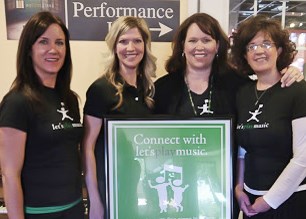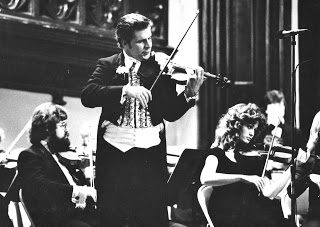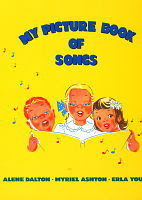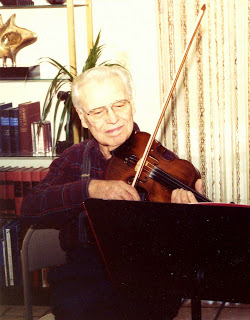Inspiring Podcast
Thursday, March 25, 2021 | Presto
I just finished Shelle's latest podcast episode featuring Annalee Dinkle, the creator of Presto! It was a real treat to hear these two creators and colaborators sharing their creative process and the early beginnings of Presto for the older beginnger!
2021 Spirit Week
Thursday, March 18, 2021 | Drum Bus
How it all began
Tuesday, March 16, 2021 | About Me
Welcome! I'm so happy you stopped by! I LOVE teaching Let's Play Music, Sound Beginnings and Presto! Here is a recent picture with my family:
.jpg)
Twelve years ago this month, I discovered Let's Play Music for the very first time through a newspaper article in the community section of the Arizona Republic -- that's right, Arizona. I first taught in Gilbert, Arizona and I fondly remember my first studio families during those years. At that time (2009) Facebook had just expanded to include regular people not currently enrolled at a university and instagram hadn't been invented yet. When I started teaching Let's Play Music, I also started blogging. Watch for a fun walk down memory lane:

An Arizona native, I moved to Utah in 2015. I love seeing the mountains every day. I have seven amazing children, two of whom are Sound Beginnings and Let's Play Music graduates. For the last 9 years, teaching Let's Play Music and Sound Beginnings has given full expression to my love for music, children, and lifelong learning. I love it! I also thoroughly enjoy my job as an Associate Trainer with the company training and mentoring new trainees. Read on for my childhood music stories.
I cut my teeth listening to Daddy practice. Dad insisted a violin produced the purest sound.
 |
| Wieniawski Violin Concerto with the University of Idaho Symphony, 1978 |
I consider it a privilege to teach children Let's Play Music and Sound Beginnings and I look forward to speaking with you. Please contact me: rosalynfrancis@letsplaymusicsite.com
Learning Chords: Use the Correct Fingering
Sunday, January 19, 2020 | Parent University
What is Muscle Memory?
When our muscles learn a pattern of movement through repetition, our brains "chunk" that pattern into memory. It becomes ingrained in our MUSCLE MEMORY and takes no effort to recall, so we can perform the physical tasks without conscious effort. Our very efficient brains use muscle memory (or motor learning) to reduce the need for attention on activities that are repeated frequently. Now that you've been driving your manual-transmission car for so many years, you can focus on things around you without having to think about shifting. Now that you've been typing for so many years you can blog as fast as you can think up the words to share!
Muscle Memory at the Piano
Your second-year Let's Play Music student is hard at work learning the Red, Blue, and Yellow chords with right and left hands. Your teacher (and booklet) demonstrate the fingering your child should use to play each chord. It is crucial that you help your child learn these exact hand-shapes, even if your child finds something that initially seems easier (like using the stronger finger 3 instead of finger 2). As your child progresses in music, these shapes will come up time and again- we want your child's fingers to automatically know exactly how far to move or reach to play these shapes! It will make future piano pursuits SO much easier. This is the same reason we insist that you use a keyboard with full-sized keys: your child's hand is memorizing exactly how far to stretch, and will forevermore remember the distance that "feels like" the intervals we've learned.
Once the brain has the "feel" for these chords and intervals memorized, that will free up the pianists attention to other things, like the progression of chords and the notes on the page! Playing and sight-reading become easier when the pianist looks for common chord-shapes and melodic patterns, then lets her hands "do it" without having to think!
Practice Makes Permanent
You were hoping "practice makes perfect", right? Sorry! Only perfect practice will get you there. Sloppy practice will lead to permanent sloppy results. So, here's what your brain needs to help you wire in the best muscle memories:
1. Repetition: Playing these chords and completing the Let's Play Music program should give your child enough repetition to have them stick for a lifetime!
2. Attention to Technique: Watch your child to look for bubble-hand, fingers touching keys, and correct fingering. Remind your child it's better to have good technique and go slow at first.
3. Visualization: Muscle-memory is a brain activity! It's almost as powerful to THINK of doing this correctly as it is to actually do it. When you go on that spring break trip, bring along the keyboard image from your songbook and have your child "practice" on it.
How To Help Your Child Learn the Chords
When first learning, movements will be slow. Lots of mental focus will be required to engage just the exact fingers and to move them (or stop them from moving) just the exact amount. Be aware that correct fingering is the most important thing at this point- NOT SPEED! Lovingly remind your child to slow down and not go faster on chord transitions than she can go with correct fingering.
For the Right Hand Yellow Chord or the Left Hand Blue Chord, have your student practice sliding her thumb over one key, and then back home, without playing any notes. Focus on keeping the other fingers in place, curved and gently touching their keys. When fingers float up into the air, the child loses the muscle sense of how they must be positioned. After warming up with finger-sliding, slowly transition back and forth between chords.
For the Right Hand Blue Chord or the Left Hand Yellow Chord, have your student practice extending the hand, all fingers sliding over into position, and then sliding back home. This time the thumb is the anchor-it is critical the thumb remains gently touching the key or the pianist will have to look down at her hands to see where to set them. Simply sliding back and forth helps the hand start to learn the exact distance to move! After this warm-up, slowly transition back and forth between chords.
In this short video clip, I show a warm-up and some chord transitions, along with a simple game using dice to determine how many times she plays each chord before transitioning. At first I give extra beats during the transition, and when she gets better I'll expect her to transition and continue playing without missing any beats.
Practice Playing Chords [less than 3 minutes]
In this second video, I show a common error: playing the Yellow chord with finger 3 instead of 2. I tell my daughter this finger is UNDER ARREST! or IN JAIL! and it's not allowed to leave the white key it is hand-cuffed (finger-cuffed) to. In this video, I actually do restrain her finger from leaving the white key, but after this one time, I won't touch her hand again- I'll just say "put that finger 3 back in handcuffs!" and she will giggle and stick it back in place.
https://youtu.be/Ub_mYRPX3hY?si=EyGR0s0jd3eXUYvv [45 seconds]
What's Next?
As your child masters the chords, she'll be delighted to have fun sight-reading music with red, yellow, and blue chords! It will take very little effort for her hand to move into position and keep up with new music. In the third year of Let's Play Music, she'll use these same hand-shapes to play chords in other keys AND to play chords with different inversions. After graduating Let's Play Music, she'll find these same chord shapes, intervals, and melodic patterns in written music everywhere and will have ease in playing them because her muscles have learned the patterns.
-Gina Weibel, MS
Retired Let's Play Music Teacher
Official Let's Play Music blog: http://makingmusicianslpm.blogspot.com



